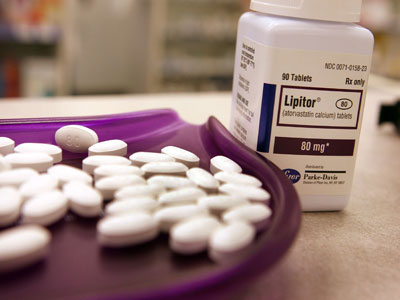
New Research Changes the Perception of Statins and Liver Disease
Statins and Liver Disease
by Nicole Cutler, L.Ac.
According to the American Heart Association, well over 100 million American adults have high cholesterol, a condition that is frequently controlled with lifestyle modifications and cholesterol-lowering medications. Positively affecting all aspects of the cholesterol profile, statins are the most commonly prescribed type of cholesterol-lowering medication.
Despite their beneficial advantages, statins have a reputation for side effects – one of the most notable of which is the elevation of liver enzymes. Although this potential problem presents a warning flag to those with chronic liver disease, a new study claims just the opposite: that statins are actually helpful to those with non-alcoholic fatty liver disease (NAFLD).
About Statins
Statins block the enzyme in the liver that is responsible for making cholesterol. This enzyme is called hydroxy-methylglutaryl-coenzyme A reductase (HMG-CoA reductase). Scientifically, statins are referred to as HMG-CoA reductase inhibitors. In addition to blocking this enzyme, statins help the body reabsorb cholesterol that has built up in plaques along artery walls. This re-absorption action prevents further blockage in the blood vessels, thus reducing the occurrence of strokes and heart attacks.
Some well-known statins, include:
· Atorvastatin – Lipitor
· Simvastatin – Zocor
· Lovastatin – Mevacor
· Pravastatin – Pravachol
· Rosuvastatin – Crestor
Statins help many people with high cholesterol prevent and treat atherosclerosis, the accumulation of cholesterol-containing plaques in the inner lining of the arteries. Despite its benefits, there are two potentially serious statin side effects:
1. Liver Damage: All statin drugs have been shown to elevate liver enzymes to some degree. When liver enzymes, aspartate aminotransferase (AST) and alanine aminotransferase (ALT), are too high, they indicate injury to liver cells. Although there have been reports of liver failure and hepatitis associated with statins and elevated liver enzymes, these occurrences are relatively rare.
2. Muscle Pain and Weakness – Otherwise known as myopathy, muscle weakness and pain are a rare side effect of statin use. Myalgias can be mild, but they can also be severe, as in the life-threatening condition known as rhabdomyolysis.
Not surprisingly, the first of statin’s most severe side effects dissuade many practitioners from choosing this medication for patients with chronic liver disease.
About NAFLD
Affecting an estimated 20 to 30 percent of Americans, non-alcoholic fatty liver disease is one of the most common causes of chronic liver disease. Encompassing a spectrum of conditions marked by fat accumulation in liver cells, NAFLD can range in severity from:
Steatosis– simple fatty liver
Non-Alcoholic Steatohpatitis (NASH) – fatty changes with inflammation and liver injury
Although steatosis is a benign condition, NASH can progress to cirrhosis and lead to end-stage liver disease.
New Perspective on Statins
Reluctance to use statins on those with liver ailments is widespread; however, new research challenges this sentiment. Published in a November 2010 online edition ofThe Lancet, research in Greece and the United Kingdom found that long-term use of statins can actually improve liver function in certain individuals.
The study evaluated over 400 patients with moderately abnormal liver tests, all who were believed to have NAFLD. Approximately half received statins while the remaining half received no treatment. After three years, the researchers found the following:
Those taking statins did not have a higher rate of liver problems than the control group.
Those taking statins had decreased or normalized levels of ALT, while the control group’s worsened.
Those taking statins had a 39 to 68 percent reduced risk of cardiovascular events, such as heart attack and stroke.
One of the most common side effects of statins is known to be liver enzyme elevation. As such, those with chronic liver diseases were typically steered away from this cholesterol lowering medication.
Since new evidence points out that those with elevated baseline liver enzyme levels (likely having NAFLD) can benefit from taking statins, there is a surge of hope that these drugs can control cholesterol and minimize liver damage from NAFLD.
References:
http://cholesterol.about.com/od/statindrugs/a/statindrugse.htm, Are Statin Side Effects Worth The Price In The Fight Against Heart Disease?, Jennifer Moll, Retrieved December 3, 2010, About.com, 2010.
http://www.americanheart.org/presenter.jhtml?identifier=4506, Cholesterol Statistics, Retrieved December 3, 2010, American Heart Association, 2010.
http://www.businessweek.com/lifestyle/content/healthday/646408.html, Statins OK for Patients With Abnormal Liver Function: Study, Retrieved November 30, 2010, Bloomberg L.P., 2010.
http://www.clevelandclinicmeded.com/medicalpubs/diseasemanagement/hepatology/nonalcoholic-fatty-liver-disease/#s0015, Nonalcoholic Fatty Liver Disease, Anna Wieckowska, William D. Carey, Retrieved November 30, 2010, The Cleveland Center Clinic for Continuing Education, 2010.
http://www.mayoclinic.com/health/statins/CL00010, Statins: Are these cholesterol-lowering drugs right for you?, Retrieved December 3, 2010, Mayo Foundation for Medical Education and Research, 2010.
http://www.medicinenet.com/statins/article.htm, Statins, Retrieved December 3, 2010, MedicineNet, Inc., 2010.
http://www.ncbi.nlm.nih.gov/pubmed/21109302, Safety and efficacy of long-term statin treatment for cardiovascular events in patients with coronary heart disease and abnormal liver tests in the Greek Atorvastatin and Coronary Heart Disease Evaluation (GREACE) Study: a post-hoc analysis, Athyros VG, et al, Retrieved November 30, 2010, The Lancet, November 2010